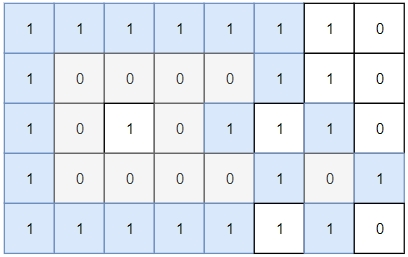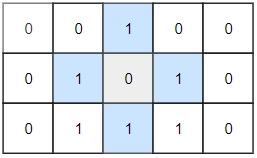Number of Closed Islands
Given a 2D grid consists of 0s (land) and 1s (water). An island is a maximal 4-directionally connected group of 0s and a closed island is an island totally (all left, top, right, bottom) surrounded by 1s.
Return the number of closed islands.
Example 1:

Input: grid = [[1,1,1,1,1,1,1,0],[1,0,0,0,0,1,1,0],[1,0,1,0,1,1,1,0],[1,0,0,0,0,1,0,1],[1,1,1,1,1,1,1,0]]
Output: 2
Explanation:
Islands in gray are closed because they are completely surrounded by water (group of 1s).Example 2:

Input: grid = [[0,0,1,0,0],[0,1,0,1,0],[0,1,1,1,0]]
Output: 1Example 3:
Input: grid = [[1,1,1,1,1,1,1],
[1,0,0,0,0,0,1],
[1,0,1,1,1,0,1],
[1,0,1,0,1,0,1],
[1,0,1,1,1,0,1],
[1,0,0,0,0,0,1],
[1,1,1,1,1,1,1]]
Output: 2Constraints:
1 <= grid.length, grid[0].length <= 1000 <= grid[i][j] <=1
class Solution {
public int closedIsland(int[][] grid) {
// Marking border islands
boolean[][] visited = new boolean[grid.length][grid[0].length];
for (int i = 0; i < grid.length; i++) {
if (grid[i][0] == 0 && !visited[i][0])
markerDFS(grid, visited, i, 0);
if (grid[i][grid[0].length - 1] == 0 && !visited[i][grid[0].length - 1])
markerDFS(grid, visited, i, grid[0].length - 1);
}
for (int j = 0; j < grid[0].length; j++) {
if (grid[0][j] == 0 && !visited[0][j])
markerDFS(grid, visited, 0, j);
if (grid[grid.length - 1][j] == 0 && !visited[grid.length - 1][j])
markerDFS(grid, visited, grid.length - 1, j);
}
int count = 0;
// Counting inner islands
for (int i = 0; i < grid.length; i++) {
for (int j = 0; j < grid[0].length; j++) {
if (grid[i][j] == 0 && !visited[i][j]) {
markerDFS(grid, visited, i, j);
count++;
}
}
}
return count;
}
public void markerDFS(int[][] grid, boolean[][] visited, int x, int y) {
if (x >= 0 && x < grid.length && y >= 0 && y < grid[x].length && grid[x][y] == 0 && !visited[x][y]) {
visited[x][y] = true;
markerDFS(grid, visited, x + 1, y);
markerDFS(grid, visited, x - 1, y);
markerDFS(grid, visited, x, y + 1);
markerDFS(grid, visited, x, y - 1);
}
}
}Last updated